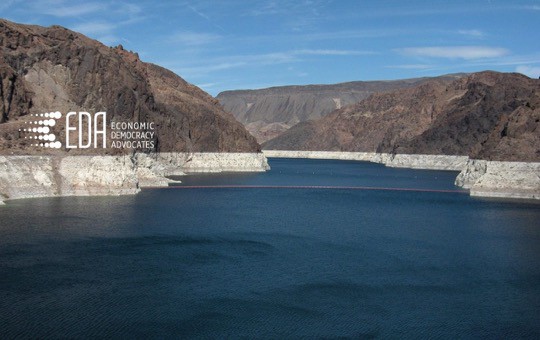In the United States, it seems as though California’s water shortages are constantly in the news. And while the month of January this year saw some relief with a welcomed influx of weeks of rain, we can assume that we’ll begin to hear the stories once again about water shortages and the need for conservation. If the state and its residents fails to act, water availability at every tap could be in jeopardy. This article offers some hope that a plan is finally in place that will make a difference to the residents of California, and could offer a template for other states facing this very real issue.

A worker adjusts a water irrigation system in a field near San Ysidro, Calif., in March. (Mike Blake/ Reuters)
SANTA MONICA, Calif. — Here in the land of beauty and make-believe, it’s important to keep up appearances. Tracy Quinn sees it whenever she walks her dog: sprinklers irrigating pretty green lawns and wasted water bleeding across sidewalks during the state’s driest spell in centuries.
“It drives me crazy,” said Quinn, a water policy analyst for the Natural Resources Defense Council.
But now California is preparing for a dramatic change in how its residents use water. A water management plan that could be finalized in January is designed to make conservation “a way of life.”
“I think it’s a really great way to go,” Quinn said.
California is entering its sixth year of extreme drought, and it has enacted water restriction plans before. In 2015, Gov. Jerry Brown (D) declared that watering grass every day was “going to be a thing of the past.” He issued an executive order that forced the state’s 410 water agencies to cut up to 36 percent of their water use, compared with 2013.

Firefighters battle the Erskine Fire by lighting back fires in Lake Isabella in central California. Investigators say an electrical line in a tree sparked the devastating wildfire, which killed an elderly couple and destroying hundreds of homes. (Casey Christie/Associated Press)
The new plan would instead give each water agency a budget for how much water its customers are allowed to use. Each agency’s allowance would be based on estimates from state officials of its demographics — population, economy, outdoor temperature, tree canopy and even the rate of water evaporation — to determine its need.
Many agencies will be forced to purchase costly technology that detects even the smallest leaks in water lines and to hire data analysts to record and report water use. An association that represents California water agencies said it has yet to examine the overall cost but predicted it would easily surpass $1 billion.
For the first time, farms in the state would be required to account for nearly every drop of water they pull from aquifers they are depleting, often to grow thirsty cash crops such as almonds and rice that require extensive irrigation in naturally dry conditions.
The proposal, “Making Water Conservation a Way of Life,” must overcome a slew of public and legislative debates over the next three years before implementation, but it is being embraced by strange bedfellows: The Association of California Water Agencies and environmental groups such as California Coastkeeper Alliance that often battle the association over water.
“It’s sweeping change that builds on the lessons learned during the drought,” said Max Gomberg, the climate and conservation manager for the state Water Resources Control Board, which governs water agencies. “We are setting new water efficiency targets for suppliers that serve 34 million people.”
“We’re not telling them how to meet their budgets. We’re just telling them they have to stay within their budgets,” he said. “If you stay under budget, kudos. If you go over budget, the state steps in.”

Irrigation water runs along a dried-up ditch between rice farms in Richvale, Calif. (Jae C. Hong/Associated Press)
The penalty for going over budget is one of the many things that state water officials, lobbyists and lawmakers will have to negotiate. What’s important now, Gomberg said, is that there is a new path forward.
During the state’s emergency drought response two years ago, “we realized . . . we didn’t have a regulatory structure dealing with leaks” in cities, Gomberg said, and “we didn’t know how much water was being lost” in rural areas, where farmers were never required to report their groundwater use.
Scientists say there is no end in sight for California’s drought. The dry stretch that started in 2011 has killed more than 100 million trees, increased the chances of wildfires, wiped out dozens of farms, dried sections of rivers and threatened the state’s salmon fishery, killed unknown quantities of wildlife and left entire communities without running water.
San Diego County built the largest desalination plant in the nation, pulling salt water from the ocean. Santa Barbara is following suit, seeking to restart a mothballed desalination plant as a reservoir that serves the county, Lake Cachuma, goes almost dry. In East Porterville, near Fresno, residents couldn’t bathe or flush their toilets after their wells stopped pumping.
Setting water budgets will involve a lot of technical work in the nation’s most populous state — and, before the drought, one of the most irresponsible when it came to water management.
For example, until recently even major cities, including the capital, Sacramento, did not require homes and businesses to have water meters. Now California will require thousands of sophisticated meters and will combine satellite technology and aerial flight data to study the state’s topography to see which areas have the most pavement, grass and even the most shade to determine how much irrigation they need.
Foggy San Francisco’s water budget will be different from dry and highly populated Los Angeles’s, Gomberg said. Bakersfield, near the relatively wet Sierra Nevada, will have a budget that differs from Riverside, near dry desert mountains.
“I’m not going to say it’s perfect,” said Quinn of the Natural Resources Defense Council, “but the framework the governor put out is smart, and the potential implementation is smart for the way we manage water in California.”
The executive director of the Association of California Water Agencies, Tim Quinn (who is not related to Tracy Quinn), was equally positive. “We’re fully supportive of this effort,” he said.
Association members are not of one mind on the proposal, but “one reason a lot of our members like this budget-based approach is . . . we believe it allows agencies to adapt to their own circumstances” rather than facing a one-size-fits-all solution.
But some smaller agencies that lack money for pricey gadgets and new staffers are worried. In webinars held by the association, member agencies that serve few customers have wondered aloud whether the old order — reducing a percentage of water use — would allow them to sidesteps the costs.
“No one is looking for a way out; we’re just having a discussion . . . about what’s the best way to do it,” Quinn said.
At the Moulton Niguel Water District in south Orange County near Laguna Beach, which already monitors nearly every drop of water, the cost of new meters, leak detection equipment, a consulting analyst and increased staff work hours amounted to $78,000 yearly.
But the investment was worth it, said Joone Lopez, the district’s general manager. Leaking water is money down the drain. “It’s not only the water loss but also loss in revenue, so it makes sense to do water audits for a variety of reasons,” Lopez said.
That is why big agencies that fought the executive order to cut at least a quarter of their water use in many cases prefer the new approach. Cutting water use hurt revenue and profit margins, sometimes resulting in losses. A budget based on their needs and their ability to monitor and account for water puts destiny in their own hands.
Californians should expect a drier future, said Sara Aminzadeh, executive director of the California Coastkeeper Alliance, based in San Francisco. “We’re going to be experiencing more drought, and more severe drought with less rain and snow.”
Scientists at Stanford University predicted that the state’s temperatures will keep rising as precipitation falls, and scientists at NASA and Columbia University said that if the climate continues to warm without decreases in greenhouse-gas emissions, California and the Southwest will face a megadrought — extreme dry conditions that last 30 years.
The proposal, Aminzadeh said, “is a new ethic for our state, that water conservation is part of our way of life. We’re not just lurching from one drought to the next. We’re putting in place a long-term plan. It just feels like things are coming together.”
Article written by Darryl Fears


